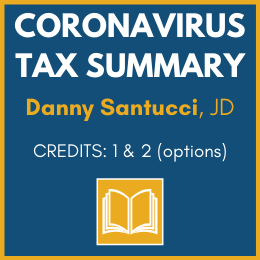
Guest Post: Divorces to Surge in Post-Pandemic Era

Danny Santucci, BA, JD, is a prolific author of tax and financial books and articles. In 1980, Danny established the law firm of Santucci, Potter, and Leanders in Irvine, California, and went into sole practice in 1995. His practice emphasizes business taxation, real estate law, and estate planning. Speaking to more than 100 groups nationally each year, he is known for spicing up his extensive expertise with an incredible sense of humor.
Read Danny’s full Instructor bio or browse his CPE courses here.
While the coronavirus emergency has produced many unexpected consequences, rising tensions amid quarantine, job loss, financial problems, and relationship stress can tear even the strongest families apart. As a result, many expect to see a surge of divorces in the post-pandemic era.
In addition to the severe emotional issues, property division, alimony, and child support are major components to a divorce that will involve the tax professional. While recent changes to the treatment of alimony have dominated divorce taxation, property settlement and division remains pivotal. Dealing with the family residence and other real estate can be challenging but, often the most complicated assets are pension plans and IRAs. What follows is a quick review of the basics before the anticipated surge.
The tax treatment of retirement plan divisions (like other marital assets) in a divorce is generally controlled by §1041. Under §1041, no gain or loss is recognized on a transfer of property from an individual to (or in trust for the benefit of) a spouse, or a former spouse if incident to a divorce (§1041(a)). Sounds simple enough but, many approaches can be used when dividing retirement plan benefits in a divorce or separation action. These methods include:
- To the extent the participant spouse’s benefits are vested, liquid, and available for withdrawal, transferring all or a portion of the benefits to the nonparticipant spouse (present distribution method)
- Placing a present value on the benefits, permitting the participant spouse to retain those benefits and transferring other marital property to the nonparticipant spouse (present transfer of equivalent assets method)
- Having the divorce court retain jurisdiction until the benefits come into pay status and then dividing the benefits (deferred determination method)
- Giving the nonparticipant spouse the right to receive all or part of the benefits as an alternate payee under a “qualified domestic relations order” (deferred division method)
Note: Retirement plans subject to ERISA must establish written procedures for the payment of benefits under a QDRO (ERISA §206(d)(3)(A)).
The deferred division method or qualified domestic relations order is popular. A “qualified domestic relations order” (QDRO) is a judgment, decree, or court order, including an approved property settlement agreement, that is issued under the domestic relations law of a state (ERISA §206(d)(3)(B)(ii); IRC §414(o)(1)(B)). A QDRO gives a spouse, former spouse, child, or dependent of a participant in a retirement plan the right to receive all or part of the benefits as an alternate payee that would be payable to the participant under the plan.
The order must contain the following specific information:
- The name and last known mailing address of the participant spouse and each alternate payee
- The amount or percentage of the participant spouse’s benefits to be paid to each alternate payee or how the amount or percentage is to be determined
- The number of payments or the period to which the order applies
- Each plan to which the order applies (ERISA §206(d)(3)(C); IRC §414(p)(2))
On the other hand, a QDRO must not require a plan to provide:
- Benefits not otherwise provided by the plan
- Increased benefits (determined based on actuarial value)
- Payment of benefits to an alternate payee that are required to be paid to another alternate payee under a previous QDRO (ERISA §206(d)(3)(D); IRC §414(p)(3))
The plan administrator must promptly notify the participant spouse and alternate payee of the procedures to determine if a QDRO meets the plan provisions. Within a reasonable time, the plan administrator is required to inform the parties of the outcome. In the meantime, the plan administrator must segregate the alternate payee’s share.
If the payee of the QDRO is a spouse or former spouse, the payee is taxed on the distribution (unless it is rolled over into an IRA) as the participant would have been taxed. Under §414(p)(8), retirement benefits paid to an alternate payee who is the spouse or former spouse of the participant are taxed to that person when the benefits are received.
For more information and specifics, see my full book and mini-courses on divorce.
Related Courses from Danny Santucci:

Danny Santucci, BA, JD, is a prolific author of tax and financial books and articles. His legal career started with the business and litigation firm of Edwards, Edwards, and Ashton. Later he joined the Century City entertainment firm of Bushkin, Gaims, Gaines, and Jonas working for many well-known celebrities. In 1980, Danny established the law firm of Santucci, Potter, and Leanders in Irvine, California. With increasing lecture and writing commitments, Danny went into sole practice in 1995. His practice emphasizes business taxation, real estate law, and estate planning. Speaking to more than 100 groups nationally each year, he is known for spicing up his extensive expertise with an incredible sense of humor.
DIG DEEPER:
How The $3.5 Trillion Budget Blueprint Could Impact Your Clients
The new reporting requirements on brokers are addressed in Section 80603 of the bill. “Broker,” by definition in Sec. 6045 (c)(1), is expanded to include “any other person who (for a consideration) regularly acts as a middleman with respect to property or services…A person shall not be treated as a broker with respect to activities consisting of managing a farm on behalf of another person.” In turn, the bill defines a “digital asset” as “any digital representation of value which is recorded on a cryptographically secured distributed ledger or any similar technology as specified by the Secretary.




